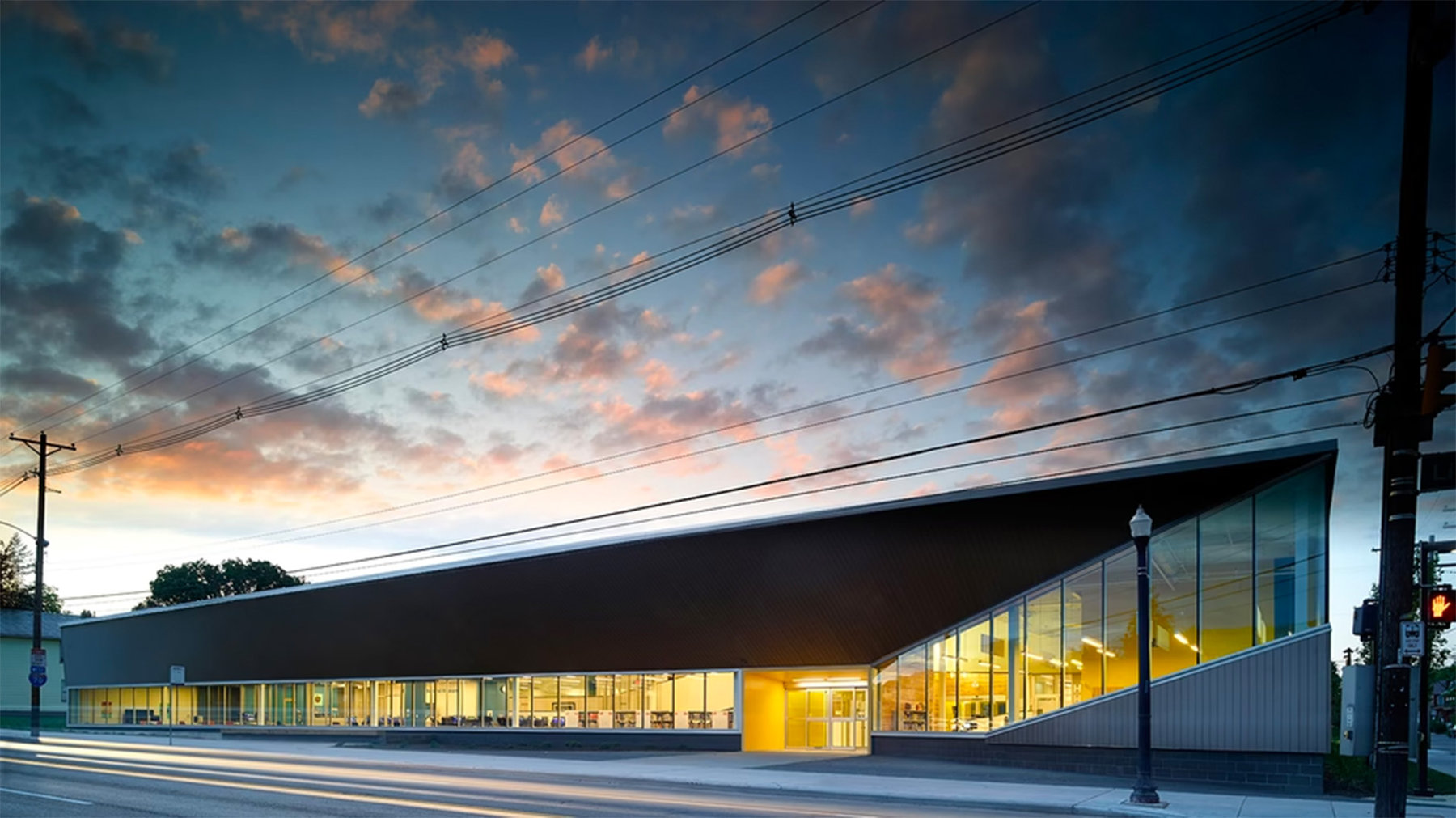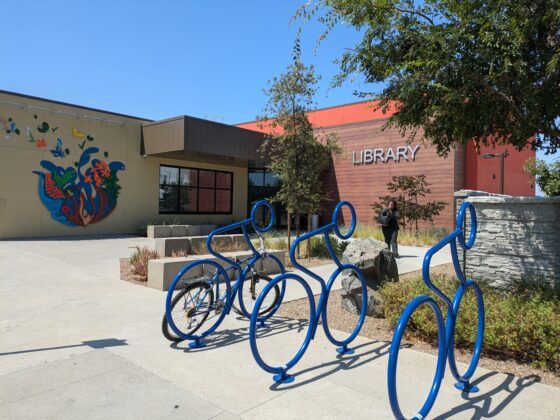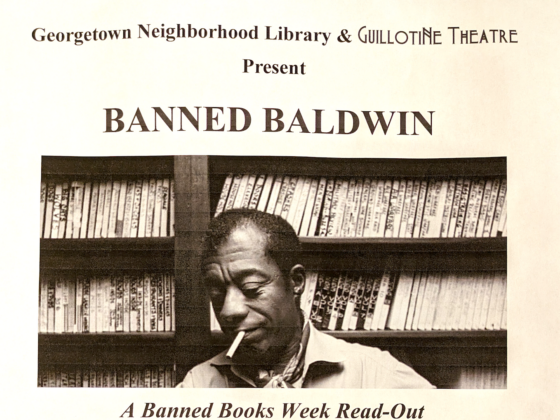The Columbus Metropolitan Library recently asked its Facebook followers to give them ten words: five to describe the library of their youth and five to describe the library of the future, 20 years from now. Here are the word clouds they assembled from the results, starting with the libraries of their youth:

If you’re beyond your teenage years, I bet this retrospective word cloud will make sense to you. Now, how about this one, describing libraries of the future:

I visited libraries recently in downtown Columbus, Ohio, and talked with Patrick Losinski, the CEO of the Columbus Metropolitan Library (CML) system, which includes the flagship main library and 21 branches around Franklin County. His title alone, CEO, should be a hint about how progressive the libraries of Columbus are, and how serious the city is about placing the libraries front and center in its trajectory toward a modern, relevant, connected city.
I walked to the library from the throwback Comfort Inn & Suites where we were staying, at the edge of German Village, one of Columbus’s historic, now trendy neighborhoods. (By the way, at Comfort Inn, be sure to look for Scott, the evening clerk. Ask him any mundane question about where to eat, visit, or wander around, and he will come back with a stunning 20-minute soliloquy including historical, architectural, culinary, economic, and literary information, which he delivers as rapid-fire as an auctioneer. Hurry, he probably won’t be there long.)
At 9:30 on the recent weekday morning when I went to visit, there were just a few people sitting on benches outside the library, with their smartphones and coffee. Losinski said I missed the real morning rush, around 8:55, when a predictable 20 or 25 people, and twice that in the winter, will be lined up and waiting to enter.

Around the turn of the 20th century, when the Columbus library was outgrowing its space, city librarian John Pugh boarded a train for New York City to knock on the door of Andrew Carnegie, whose philanthropy funded 1700 libraries around America. Would Carnegie build a library for Columbus? The conversation didn’t go well, until Pugh started over in his childhood Welsh, to which Carnegie responded in his native Scottish dialect. The cultural, if not linguistic bond (both are Celtic languages, although long-ago diverged) seemed to make a difference.
Eventually Carnegie agreed and offered $200,000, more than was usual in his library program, to build the elegant granite and marble Romanesque building. It is truly beautiful.
Losinski quips that the original construction cost would about cover a thorough cleaning of the library these days. The library has now begun an ambitious building expansion, part of a 120 million dollar expansion throughout the entire system. It will feature, among other things, replacing the solid back wall of the building with two stories of windows, where readers will overlook the existing Topiary Park, a seven-acre tree park and garden, which is groomed to represent Seurat’s famous post-impressionist painting, Sunday Afternoon on the Isle of La Grand Jatte. Completion is scheduled in time to host the 2016 World Congress of the International Federations of Library Associations and Institutions (IFLA), which will be held in Columbus. The city won rights to host the Congress in an Olympic-venue type competition.

The library system already puts up impressive numbers–as of 2013, nearly 800,000 cardholders, 6.5 million in-person visits, 6.9 million web visits, 15 million books circulated, and almost 800,000 eBook downloads.
But the library community knows that it is on a more complicated mission than simply putting up traditional numbers. When the Pew Internet & American Life Project asked people in 2012 what libraries should offer the public, the overwhelming response focused on education and reading. Some 85 percent said that libraries should work more closely with local schools. And 82 percent said they should offer free literacy programs for young children. Indeed, the Columbus library system was already headed in this direction as a major strategic focus, spurred by a sense of urgency from findings from the past 7 or so years from the Ohio Department of Education.
In the city of Columbus, the study found, about 35 percent of preschoolers were “Not Ready for Kindergarten.” What does this mean? Well, for example, when a 5-year-old walks into kindergarten, takes a book and holds it upside down, you know there is no reading readiness there. Only about 60 percent of exiting 3rd graders had reached the “Third Grade Reading Achievement”, suggesting that those same 35 to 40 percent of the kids didn’t make much progress in their last four years. Dreadful.

The library system’s answer to this problem is a set of labor-intensive hands-on programs. For a million dollars, the Ready for Kindergarten program settles into the neediest neighborhoods. They scout for families in laundromats, shops, clinics, shelters, churches, anywhere they can find them. Teams of library staff visit homes of these families regularly, kits with board books and bath-sponge letters in hand, and invitations to the library and story hours, all pointing toward helping families get started toward kindergarten a few years away.
The libraries have launched a number of other programs as well. They set up after-school help centers for homework, stocked with textbooks from their schools, supplies, computers, and a legion of community volunteers overseen by library staff. They have logged 78,000 visits so far and counting. They began a reading-buddies program for early readers and created a summer reading club. They deliver books to schools that need them. And my favorite: They stock school buses with books, 5000 of them. Bus drivers are reporting better behavior. There is more, but you get the idea.
The challenge next up and underway: Are the programs delivering? Losinski is clear in saying that none of these programs matter if they aren’t working. Over the next few years, they plan to find out if these works-in-progress are being effective.
Education efforts in Columbus libraries are a continuum from the kids on through “life skills” for adults. This means adult literacy programs, career and technology literacy, and financial literacy. Here is a true story that gives a sense of the realities: A young man comes into the library seeking help with a job search and filing his application for work. A librarian helps him load the application onto the screen. They agree he’ll fill it out and she’ll return to look it over. The librarian returns to discover the man has completed the application, not by keying in the responses, but with a marking pen on the screen.

Libraries all across the U.S. are trying to look ahead and plan their way as the traditional, shrinking analog world becomes more digital. Fact: About 32 percent fewer books were purchased by libraries over the last five years. Good news: Walk into just about any library now and you’ll see the public at free computers. Next challenge: how to safeguard access to digital content, which operates with a different system and set of standards than traditional book acquisition, from who controls the access to what are the copyright laws. (Debates about libraries’ rapidly evolving role are the subject of extensive online analysis. For a place to start, see this post by David Rothman and this report from the Pew Internet project.)
Being sure of affordable and unfettered access to digital content is something Patrick Losinski worries about. And he also appreciates the upside of shifting to digital content: There is an opportunity to redeploy library staff from labor-intensive, low return activities like managing and maintaining and processing books to high-value, high-return work, like more personal visits to prepare families for their children’s success in school or time to connect face-to-face with local neighborhood schools.
I returned to the library several times, wanting to get a feel for the culture of the library. To me, a very interesting commitment in Columbus is to run the library like a service business. Remember, Losinski has the title of CEO, and the public who come to use the library are referred to as customers, not patrons. What does that mean in practice, I wondered.

Here is what I noticed: When I walked into the library (as I did anonymously), I thought the guard treated me less as a security risk and more like someone who could use help or guidance. Subtle, but something I have become attuned to from living in and around federal buildings in Washington, D.C. In the coffee shop, which I visited on three different days because they served great lattes, the serving staff was patient, informative, and really friendly.
Since I grew up in Ohio, I knew that some of this is just the Ohio-nice attitude. But even on that metric, people are nice in Ohio and they are really nice at the Columbus public library. I stopped by the library shop and found a great book on the history of aviation in Columbus, delivered with more friendly conversation, much more like my favorite neighborhood restaurant than my grumpy local post office. It was more of the same at the reference desk, where I circled around with a tentative look, was invited to inquire, then, not able to think of anything else, I asked if they had any copies of Dreaming in Chinese (my book!). Luckily they did—7 copies!—and I sheepishly admitted my connection to it. It turns out I wasn’t the only “secret shopper” in the library; Losinski admitted to me that it is a tactic he uses to track how well his staff is carrying out this soft diplomacy of the library mission.

There is an inscription above the entry to the library, in big, bold letters: OPEN TO ALL. You cannot miss it. In a country as diverse as America, ALL is a big word. In Columbus, it is first-and-foremost literally true. It also means there is a guard in every library location for security and safety. It means there are expectations for appropriate behavior, which are transparent: no sleeping, no bathing, and in case of strong odor, counseling on where to get to a shower. It does not mean the library is a shelter. There are warnings and penalties for inappropriate behavior; a day, or a week, out.
As we’ve seen in other towns around the U.S. on our American Futures adventure, many big undertakings like the revamping of the Columbus Metropolitan Library system, happen with the collaboration among public and private partnerships. You can read about them in Greenville, and Allentown, Pennsylvania, and the Franklinton area of Columbus.
The same applies with the Columbus library system. As for the public part, facing a loss to the library budget from state revenues, voters in 2010 passed by more than a two-to-one margin an increased tax levy for $50 million per year for better library services. As for the private part, the Library Foundation raised $500,000 last year at a gala fundraiser.

Others, like the Friends of the Library contribute in many different ways. The library’s Board of Trustees, all appointed by either the County Commissioners or the Judges of Court of Common Pleas, arrive with affiliations to powerful institutions like hospitals, investment companies, insurance companies, and the Ohio State University. Patrick Losinski repeated a version of the mantra we heard from others around Columbus, which pointed to part of what is making this city work: We’re large enough to have international companies; we’re small enough that I can call up a CEO and say “I’d like to talk to you about some things around the library.”




